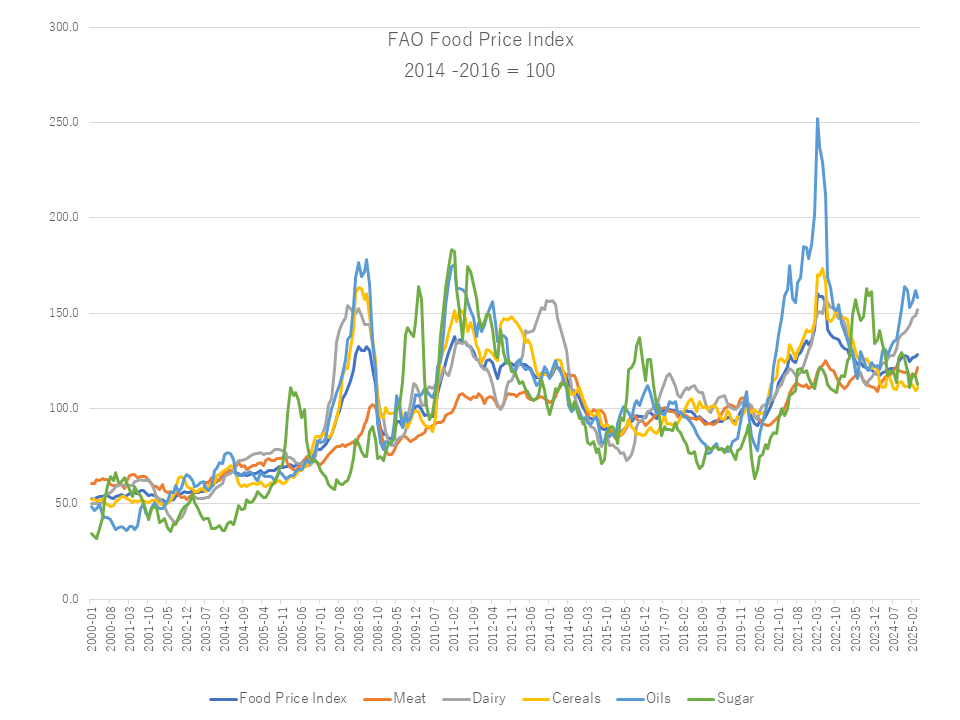Pick Up
1249. World Food Price Trends in April 2025

1249. World Food Price Trends in April 2025
The Food and Agriculture Organization of the United Nations (FAO) released the World Food Price Trends on May 2. The value for April 2025 averaged 128.3 points, up 1.0% from the previous month. Increases in the price index for cereals, dairy products, and meat outweighed declines in the price index for sugar and vegetable oil. The food price index increased by 7.6% year-on-year but remained 19.9% lower than the peak recorded in March 2022.
The Cereal Price Index increased by 1.2% month-on-month in April, reflecting higher prices across major cereals, but remained 0.5% lower year-on-year. World wheat prices rose slightly, supported by tighter exportable supplies in the Russian Federation, a solid export pace in some major exporting countries, and currency movements, especially as the US dollar weakened against the euro, but trade policy developments and macroeconomic uncertainties held back the increase. International corn prices also rose, mainly due to seasonal stock tightening and currency fluctuations in the United States, while adjustments to U.S. import tariff policy (including tariff exemptions for Mexico, a major importer of U.S. corn, and a 90-day suspension of import tariffs above 10% for several other trading partners) further contributed to upward pressure on prices. Meanwhile, the rice price index rose 0.8% in April, driven by rising demand for aromatic rice and a decline in freshly harvested rice supplies as Vietnam's main crop harvest entered its final stages.
The Vegetable Oil Price Index fell 2.3% month-on-month, but was 20.7% higher than the same month last year. The decline was mainly due to a decline in palm oil prices, which offset the rise in market prices for soybean oil and rapeseed oil. After two months of increases, international palm oil prices fell significantly in April, supported by a gradual recovery in global export supplies due to seasonal production increases in major Southeast Asian producing countries. In contrast, global soybean oil and rapeseed oil prices continued to rise, broadly reflecting, respectively, robust global import demand and tighter supplies as the end of the 2024/25 season approaches. Meanwhile, international sunflower oil prices were significantly higher year-on-year amid reduced supplies from the Black Sea region.
The Meat Price Index increased 3.2% month-on-month and 4.3% year-on-year in April. International meat prices increased across all categories, with pork prices notably increasing the most. The increase was supported by higher prices in the European Union (EU) due to higher global import demand following Germany's restoration of FMD-free status and the lifting of related restrictions by importers. Additionally, seasonal demand growth around the Easter holidays also helped. Beef prices also held firm, particularly in Australia and Brazil, on the back of robust import demand and reduced global supplies.
The Dairy Price Index rose 2.4% month-on-month in April and up to 22.9% year-on-year. The increase was driven mainly by higher European prices supported by declining stocks and firm milk fat demand, despite seasonal increases in raw milk production.
The Sugar Price Index fell 3.5% month-on-month, its second consecutive monthly decline. It was also 10.9% below its April 2024 level. The decline in global sugar prices is driven mainly by concerns over the uncertain global economic outlook and its potential impact on demand in the beverage and food processing sectors, which account for the majority of global sugar consumption. Higher-than-expected Brazilian sugar production in the second half of March, the depreciation of the Brazilian real against the US dollar, and the fall in international crude oil prices also contributed to the decline in global sugar prices.
Contributor: IIYAMA Miyuki, Information Program
